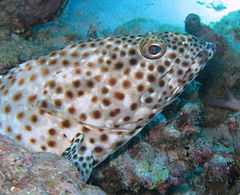Greasy grouper
| Greasy grouper | |
|---|---|
 | |
| Conservation status | |
| Scientific classification | |
| Kingdom: | Animalia |
| Phylum: | Chordata |
| Class: | Actinopterygii |
| Order: | Perciformes |
| Family: | Serranidae |
| Genus: | Epinephelus |
| Species: | E. tauvina |
| Binomial name | |
| Epinephelus tauvina (Forsskål, 1775) | |
The greasy grouper (Epinephelus tauvina), also known as the Arabian grouper, is an Indo-Pacific fish species of economical importance.
The fish grows up to 75 cm in length. Its head and body are pale greenish grey or brown with round spots, varying from orange-red to dark brown. A group of black spots may be visible on the body at the base of the rear of the dorsal fin. Five vertical darker shaded bars may also be present on the body. It is similar to E. corallicola and E. howlandi, which, however, have shorter bodies and spots less closely spaced.
It is widely distributed from the Red Sea to South Africa, as far north as Japan, and in the waters around Australia. It is found in clear water areas associated with coral reefs up to 300 m deep, where it feeds on smaller fish.
Eating this fish may be associated with ciguatera poisoning.
Due to confusion about identifying species, much of the earlier (particularly pre-1984) literature referring to E. tauvina actually is about other species of grouper, including Epinephelus coioides, Epinephelus malabaricus and Epinephelus lanceolatus.[1]
Habitat
Salt water
Dispersion
The gulf of Thailand and Andaman Sea
Utilization
Fishery: Small Trading ; Aquaculture: Trade ;Game : Angling
References
- Froese, Rainer and Pauly, Daniel, eds. (2007). "Epinephelus tauvina" in FishBase. 4 2007 version.
- ↑ 1.0 1.1 Epinephelus tauvina IUCN Red List (2014)
